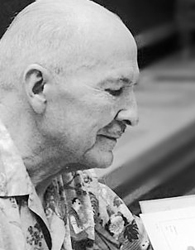Science fiction Grand Master Robert A. Heinlein inspired many readers with his predictions of technologies to come, his vivid descriptions of outer space, and his often controversial ideas about how we might react to what we find there.
Robert Heinlein’s Early Days
Born on July 7, 1907, in Butler, Missouri, Robert Anson Heinlein took an early interest in science and astronomy. He enrolled in the Naval Academy in 1925, and served on both the Lexington and the USS Roper after graduation.
Severe seasickness handicapped him aboard the Roper, and he eventually developed pulmonary tuberculosis. According to William H. Patterson Jr., Heinlein was left “totally and permanently disabled” from his illness and retired from the Navy in 1934.
Heinlein had an affinity for physics and mathematics, and took classes in both from the University of California. Heinlein tried managing a silver mine in Colorado and also ran for public office in the California State Assembly in 1938.
Sources in this Story
- Heinlein Society: Biographies of Robert and Virginia Heinlein
- The New York Times: Robert Heinlein Is Dead at 80; Renowned Science-Fiction Writer
- The Wall Street Journal: Robert A. Heinlein’s Legacy
- The New York Times: Heinlein’s Prophetic First Novel, Lost and Found
- National Space Society: Heinlein Award
- The Space Review: Griffin, Heinlein, and spaceflight
Heinlein’s Science Fiction Writing
In 1939, Heinlein sold his first science fiction story, “Life-Line,” for $70. Heinlein had hoped to return to military service after Pearl Harbor was attacked, but instead, he worked at the Philadelphia Naval Aircraft Factory with fellow writers L. Sprague de Camp and Isaac Asimov.
He wrote adventure stories for boys throughout the late 1940s and 1950s, and in 1958 wrote “Starship Troopers.” Robert Heinlein was one of the first writers to introduce science fiction to mainstream magazines like the Saturday Evening Post. One of his most famous novels is “Stranger in a Strange Land,” for which Heinlein won a Hugo Award and which became the first science fiction novel to make The New York Times bestseller list. Heinlein received the first Grand Master Award for lifetime achievement from Science Fiction Writers of America in 1975.
Heinlein’s Work
- “Starship Troopers”
- “Stranger In A Strange Land”
- “The Moon is a Harsh Mistress”
- “Time Enough for Love”
- “For Us, The Living”
The Rest of the Story
By the time Heinlein died on May 8, 1988, he had published more than 60 novels and a multitude of short stories. Years after his death, an unpublished work was unearthed.
Heinlein’s first novel had been rejected by two publishers, so he put the book away and eventually threw out the original manuscript. The novel, “For Us, the Living,” was considered lost for more than 60 years, until a copy of it was uncovered in a Seattle garage. Robert James, a Heinlein scholar, said Heinlein wasn’t writing fiction at the very beginning of his career, but “he was writing what society should be about.”
In memory of the author, the Robert A. Heinlein Memorial Award was created to honor those who have aided “the creation of a free, spacefaring civilization.” People in numerous fields, such as science, philosophy, politics and writing, are eligible to receive this award. Past recipients include Gene Roddenberry, Dr. Buzz Aldrin and Captain James Lovell.
July 2007 marked the centennial celebration of Heinlein’s birthday. During the events honoring Heinlein’s life and work, NASA administrator Mike Griffin made a speech in which he said, “to be interested in science fiction was to be interested in the works of Robert Heinlein.”
Griffin also went on to credit Heinlein with encouraging the practice of critical thinking. “Anyone can ask why,” Griffin said, “Those who make the future are the ones who ask, ‘Why not?’ Heinlein could make you ask that question.”
This article was originally written by Lindsey Chapman; it was updated June 1, 2017.











